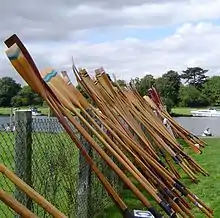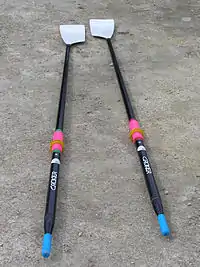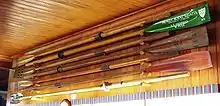Oar
An oar is an implement used for water-borne propulsion. Oars have a flat blade at one end. Rowers grasp the oar at the other end.

The difference between oars and paddles is that oars are used exclusively for rowing. In rowing the oar is connected to the vessel by means of a pivot point for the oar, either an oarlock, or a thole. The oar is placed in the pivot point with a short portion inside the vessel, and a much larger portion outside. The rower pulls on the short end of oar, while the long end is in the water. The oar is a second class lever with the water as the fulcrum, the oarlock as the load, and the rower as the force, force being applied to the oarlock by exertion of pressure against the water. An oar is an unusual lever since the mechanical advantage is less than one. The oar increases the small displacement of the end held by the rower, into a large displacement of the vessel through the water. The rower applies a large force through a small distance, which must be equaled by the small force the water applies operating over a longer distance, i.e. the work done by the rower must be balanced by the work done by the water.[1]
By contrast, paddles, are held in both hands by the paddler, and are not attached to the vessel.
Rowers generally face the stern of the vessel, reach towards the stern, and insert the blade of their oar in the water. As they lean back, towards the vessel's bow, the blade of their oars pivots in the oarlock, and the end in the water moves towards the stern, providing forward thrust.
For thousands of years vessels were powered either by sails, or by the mechanical work of rowers, or by paddlers. Some ancient vessels were propelled by both oars and sail, depending on the speed and direction of the wind.
History
Rowing oars have been used since the early Neolithic period. Wooden oars, with canoe-shaped pottery, dating from 5000–4500 BC have been discovered in a Hemudu culture site at Yuyao, Zhejiang, in modern China.[2][3] In 1999, an oar measuring 63.4 cm (2 ft) in length, dating from 4000 BC, was unearthed in Ishikawa Prefecture, Japan.[4]
Construction
Oars have traditionally been made of wood. The form is a long shaft (or loom) with a flat blade on the end. Where the oar connects to the boat there is a "collar" (or button), often made of leather, which stops the oar slipping past the rowlock. Oars usually have a handle about 150mm long, which may be a material sleeve or alternatively an ovoid shape carved to fit the hands.
Balanced oar
This is a normal, usually wooden oar to which weight has been added at the inboard end so that the blade end is noticeably lighter and easier for a rower to operate without fatigue. The two methods of adding weight are to either have a much larger section in the oar immediately next to the handle for a distance of about 450 millimetres (18 in) or to drill an 18-millimetre (0.71 in) hole inside the handle for a distance of about 150 millimetres (5.9 in) and add about 12 oz of lead secured by epoxy resin glue. For a 7-foot (2.1 m) oar the balance point is about 12 inches outboard of the rowlock. Often surplus wood is removed from the blade's width and thickness and at the neck between the blade and the shaft to further reduce outboard weight. This type of oar is much better for long-range rowing.
Oars used for transport
The oars used for transport come in a variety of sizes. The oars used in small dinghies or rafts can be less than 2 metres long. In classical times warships were propelled by very long oars that might have several oarsmen per oar. These oars could be more than a dozen metres long.
Oars used for competitive rowing


The oars used in competitive rowing are long (250–300 cm) poles with one flat end about 50 cm long and 25 cm wide, called the blade. The part of the oar the oarsman holds while rowing is called the handle. While rowing, the oars are supported by metal frames attached to the side of the boat called riggers, while the oar fits into the oarlocks at the ends of each rigger. Classic oars were made of wood, but modern oars are made from synthetic material, the most common being carbon fibre.
Oars used as trophies
The sport of competitive rowing has developed a tradition of using an oar as a memento of significant race wins. A 'trophy oar' is not presented at the end of the race as a more familiar precious metal cup might be, but rather given by the club, school or university that the winning crew or rower represented.
A trophy oar is a competition oar that has been painted in the club colours and has then had the details of the race signwritten on the face of the blade. The most common format would have the coat of arms or crest of the club or school positioned in the centre, with the crew names and the race details arranged around this.
Many older universities (Oxford and Cambridge would be prime examples, as well as Yale and Harvard) and their colleges have long histories of using the trophy oar and many examples are on display in club houses around the world.
In culture
The Norwegian municipalities of Fedje and Herøy both have oars in their coat-of-arms.
Oars have been used to describe various animals with characteristics that closely resemble the said rowing implement. The members of the Family Regalecidae, elongated deep-sea fishes, are called oarfish because their body shape is similar to that of an oar.[5] The hawksbill turtle's genus of Eretmochelys is derived from the Greek root eretmo, which roughly translates to oar. The turtle was so-named because of the oar-like shape of its front flippers.[6]
See also
References
- "2011 FISA Rule Book". FISA. p. 53. Retrieved 19 January 2013.
- Deng, Gang. (1997). Chinese Maritime Activities and Socioeconomic Development, c. 2100 B.C.-1900 A.D. Westport: Greenwood Press. ISBN 0-313-29212-4, p. 22.
- Miriam T. Stark (15 April 2008). Archaeology of Asia. John Wiley & Sons. p. 130. ISBN 978-1-4051-5303-4. Retrieved 5 October 2012.
- The Japan Times. (February 10, 1999). Oldest oar unearthed from Ishikawa ruins. Retrieved on 2008-08-13.
- Howard, Brian. "5 Surprising Facts About the Oarfish That Has Been Washing Up on Beaches". National Geographic. Retrieved 2 March 2017.
- Beltz, Ellin. "Translations and Original Descriptions: Turtles". Scientific and Common Names of the Reptiles and Amphibians of North America – Explained. ebeltz.net. Retrieved 2007-02-06.
External links
- Oar positions, 1775 – 1783 British Navy